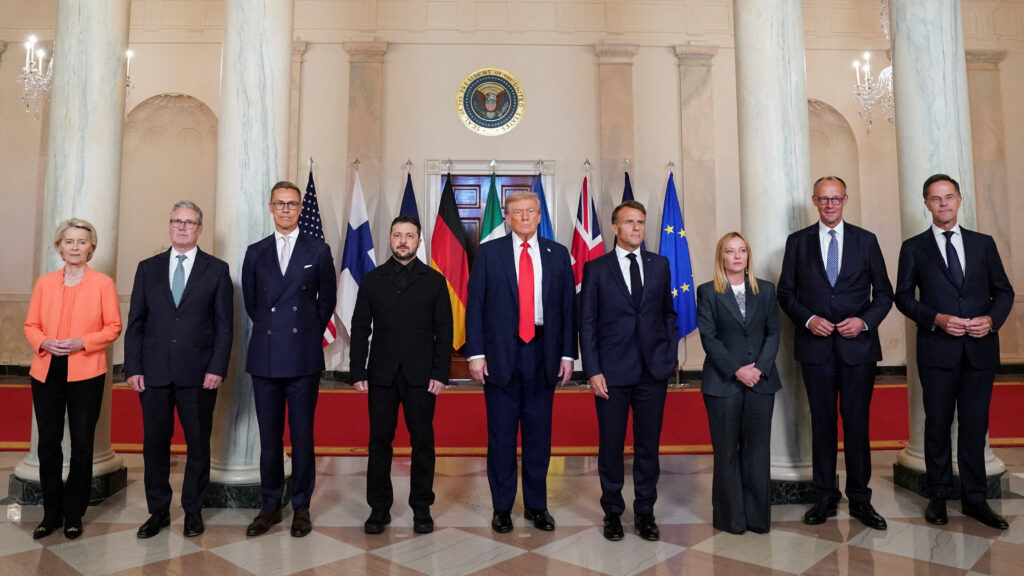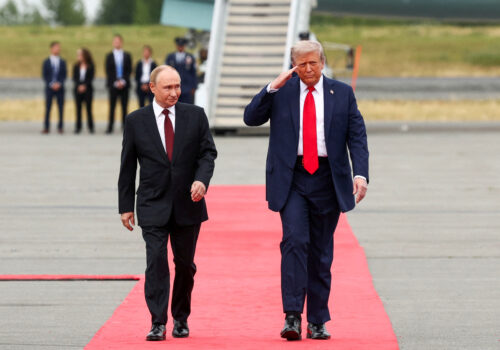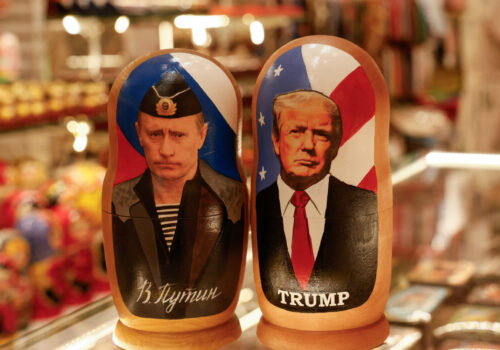JUST IN
Allies, assemble. On Monday, US President Donald Trump welcomed to the White House Ukrainian President Volodymyr Zelenskyy and seven European leaders, following Trump’s meeting with Russian President Vladimir Putin in Alaska on August 15. Among the proposals the nine-strong group discussed were two that seemed remote just a week ago: US-coordinated security guarantees for Ukraine and potential meetings involving Zelenskyy and Putin. Why this change, and what other surprises did the summit hold? Below, we’ve assembled several top Atlantic Council experts to share their insights.
TODAY’S EXPERT REACTION BROUGHT TO YOU BY
- John E. Herbst (@JohnEdHerbst): Senior director of the Council’s Eurasia Center and former US ambassador to Ukraine
- Oleh Shamshur (@Shamshur_O): Nonresident senior fellow at the Eurasia Center and former Ukrainian ambassador to the United States
- Tressa Guenov: Director for programs and operations and senior fellow at the Scowcroft Center for Strategy and Security, and former US principal deputy assistant secretary of defense for international security affairs
- Daniel Fried (@AmbDanFried): Weiser Family distinguished fellow and former US assistant secretary of state for Europe
What Trump (and Putin) are thinking
- Any “satisfaction” Putin took from his Alaska meeting with Trump “has likely been wiped away by the unprecedented meetings” at the White House, John tells us.
- While Trump did reiterate “his new-found readiness to put an immediate cease-fire aside, which so pleased Putin last week,” John notes, the US president “focused with great energy on the key issue of security guarantees for Ukraine, something that Zelenskyy had sought without success for some time.”
- Oleh takes a dimmer view of Monday’s outcomes, saying that Zelenskyy and European leaders’ attempts at “damage control after Anchorage” have “largely failed,” because Trump maintained “that peace talks can advance while hostilities continue.”
- Oleh notes that Trump repeatedly “spoke of Putin’s willingness to make peace, ignoring the fact that it was the Russian dictator who started this war against Ukraine and has prosecuted it with the utmost atrocity.”
- As talks continue, Tressa points out that Ukraine and its partners only have “wisps of possible Russian proposals and intentions,” relayed secondhand by Trump and others, with no written proposal. “It is still hard to determine whether Putin has put anything on the table at all.”
Sign up to receive rapid insight in your inbox from Atlantic Council experts on global events as they unfold.
What Europe is doing
- European leaders’ rush to appear alongside Zelenskyy for this hastily arranged summit was “part protective measure for him, part for themselves,” Tressa says, “as they scrambled to communicate their core security concerns to Trump and to bolster Ukrainian demands.”
- “It was good that Europe was at the table,” Tressa adds, “but once again European leaders were in a fundamentally reactive posture to Trump.”
What ‘guarantees’ will mean
- Dan sees “progress” from today’s talks in “putting real security for Ukraine on the table. Given the low starting point, it’s something to build on.”
- But Oleh notes that “at this stage, all proposed options amount to nothing more than ersatz guarantees,” which are essentially just “promises of enhanced security cooperation.”
- Zelenskyy floated spending some $90 billion on US weapons as part of a security guarantee and said to expect more details in the coming days. So what should security guarantees for Ukraine look like? Dan tells us that the first pillar could be the “Coalition of the Willing,” a group of European countries led by the United Kingdom and France that are “willing to consider stationing forces inside Ukraine” to enforce a peace agreement. The other pillar, says Dan, “would have to be US forces.” This would not entail “boots on the ground,” but would include “intelligence, logistics support, and significant US air power.”
What’s next
- Trump called Putin from the White House in between meetings, and he proposed Zelenskyy meet with Putin next, before a trilateral meeting with Trump. This “did not seem to go over well with Putin,” John notes, as the Kremlin only said it would appoint senior officials for the next round of talks. Russia is also rejecting the idea of any troops from NATO nations in Ukraine to enforce a security guarantee.
- That means Trump should turn up the heat, John advises, “with a few sanctions on the Russian economy—with a private message that more can be implemented quickly—and new advanced weapon supplies to Ukraine.”
- “Russian opposition to the policy steps agreed today,” John tells us, “merely underscores the need to make it harder for Putin to continue this war.”
Further reading
Fri, Aug 8, 2025
Trump and Putin just announced a meeting in Alaska. What does that mean for the war in Ukraine?
Fast Thinking By
As attention turns to the tête-à-tête in the last frontier, we turn to our experts for their insights on what to expect.
Sat, Aug 16, 2025
Ukrainians left dismayed as Trump gives Putin the red carpet treatment
UkraineAlert By Peter Dickinson
US President Donald Trump's warm welcome for Russian President Vladimir Putin was a major PR victory for the Kremlin dictator that made for particularly painful viewing in Ukraine, writes Peter Dickinson.
Thu, Aug 14, 2025
Alaska Summit: Trump wants a real estate deal. Putin wants an empire.
UkraineAlert By Peter Dickinson
US President Donald Trump appears to view peace negotiations with Vladimir Putin as a geopolitical real estate deal. But the Russian dictator is not fighting for land in Ukraine. He is fighting for Ukraine itself, writes Peter Dickinson.
Image: US President Donald Trump, Ukrainian President Volodymyr Zelenskiy, German Chancellor Friedrich Merz, French President Emmanuel Macron, British Prime Minister Keir Starmer, Italian Prime Minister Giorgia Meloni, and Finland's President Alexander Stubb, NATO Secretary General Mark Rutte and European Commission President Ursula von der Leyen pose for a family photo amid negotiations to end the Russian war in Ukraine, at the White House in Washington, D.C., U.S., August 18, 2025. REUTERS/Alexander Drago.




